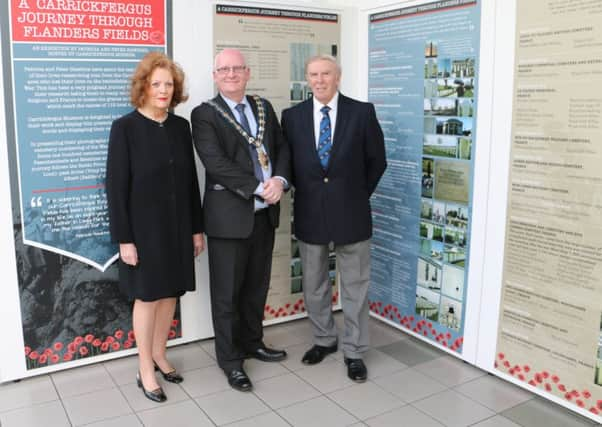Carrickfergus sons who fell in World War One remembered


Dame Patricia Hawkins-Windsor MBE, who has been living in Flanders since 1972, and her husband Peter, help with Somme Association visits from the province to Europe.
Dame Patricia told the Carrick Times: “My husband and I will be at the Ulster Tower on 1st July – we are there every year. We will also be accompanying several private groups from home who will be over for the commemorations, mainly in the Ypres area; the Ypres Salent, Passchendaele and so on, not forgetting a visit to Essex Farm where Dr John Macrae wrote his famous poem ‘In Flanders Fields’ outside his (at that time underground) Field Hospital.
Advertisement
Advertisement
“We will also be at the Menin Gate in Ypres in the evening. We will be showing people around St George’s Memorial Church.”
In April Dame Patricia spoke at the launch of the couple’s Great War Exhibition at the Civic Centre to an audience of over 100 people. It took place on the same night Councillor John Stewart introduced his book ‘Carrickfergus Great War Roll of Honour’.
Reflecting when she first lived in Lille, she told those gathered that she found that the town of Ypres in Belgium wasn’t too far away. She also became involved with St. George’s Memorial Church – built by public subscription in memory of loved ones lost in the First World War.
She continued: “I became involved with the church’s many visitors, and was always fascinated by the reasons for their visits. Duties in the church also led to many special events, and the reality of taking part on three separate occasions in actual burials, one in Ramparts Cemetery and two at Cement House Cemetery, of so many unknown soldiers only ‘Known Unto God’ still haunts me today. I wondered if one of these small boxes lying in front of me could have been that of my own great-great uncle from home with no known grave, having lost his life in Passchendaele.
Advertisement
Advertisement
“About two years ago I mentioned to Peter my husband (we both having been widowed), that, as we lived in Flanders Fields, why not try and visit as many graves as possible of the Carrick boys who had never returned, in order that we could pay respect and homage to those resting places, by visiting on behalf of their loved ones at home – those who had never been able to do so for themselves.
“Thus began our trek, covering as many areas as we could manage – Flanders Fields, the Ypres Salient, Passchendaele, and the Somme. I then put my ideas to our town Mayor, then visited our local churches and the sailing club here, comparing their Rolls of Honour with my lists from the Commonwealth War Graves Commission (CWGC) in Ypres.
“I was always very aware of what we were doing – realising that so many of the resting places and memorial panels really were being visited for the first time, buried in a foreign field.
“A most poignant moment was finding two Carrick lads’ graves side-by-side - in all our treks in Flanders Fields we had never come across that before, or since. Also in Loos we found one lad’s grave close by to Rudyard Kipling’s son’s grave.
Advertisement
Advertisement
“In one cemetery in the Somme on the road to Doullens, while visiting Samuel Kane’s grave, we also visited a little farther along Lieutenant Lionel Lupton’s Grave. He is the great-great-great uncle of the Duchess of Cambridge, Baroness of Carrickfergus. We know that at least one Carrick boy played football on Christmas Day. This was on the famous Christmas Day Truce, not far from Messines. Both sides had decided to shake hands and play football for a time that day in order to forget realities.”
The talk concluded with the guest speaker quoting from the correspondence of a mother trying to determine the fate of her son. Dame Patricia explained: “This is a letter written by an anguished mother who lived not half-a-mile from where we are sitting now, about her son – his father was the Rev. R. H. Boyd, the Minister on the Congregational Church in this town. So perhaps today – 100 years later – could I say, on behalf of us all here: ‘My mission at least partly accomplished’.”